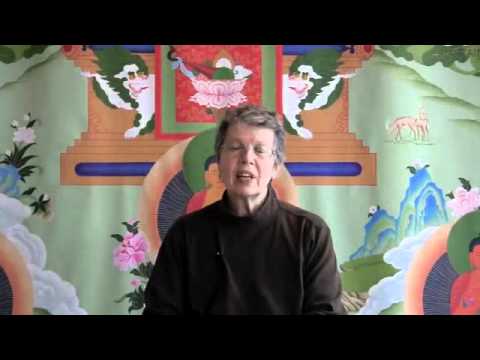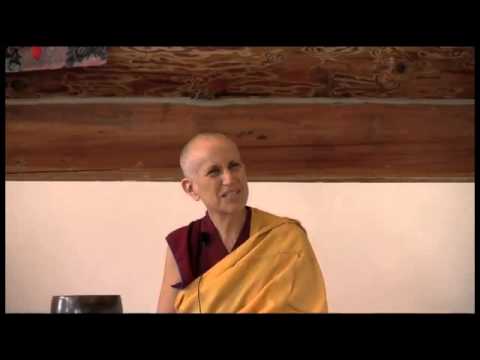Keep on going
Part of a series of teachings given at the Winter Retreat from December 2011 to March 2012 at Sravasti Abbey.
- Teachers encourage us to practice daily
- Samsara takes no days off
- The great fortune of having a precious human life in which to practice
- Practicing as a great kindness to self and other
Vajrasattva 35: Keep on going (download)
This will be the last BBC that we are doing on the Vajrasattva retreat, because tomorrow evening we begin a retreat with Professor Guy Newland. We will be looking at some commentaries on the Middle Way by Nagarjuna. We are very happy about that and really excited about this next part of our winter retreat.
The Vajrasattva part is ending, and what Venerable Chodron always says to us is (and she said it again yesterday):
What do we do? We keep going.
If this has been good for you, if it has helped your mind, if you have been able to put down some of the burden—emotionally, psychologically, any which way, then why stop? It is a good question to ask oneself. I know (that during) one of my very first retreats with Venerable—it must have been the first one because she says this every retreat—I remember that it was the only one when I was completely startled by it. We got to the end of retreat and my mind was thinking, “I want to get home, I want to get in a hot bathtub, I want to sleep in, I want to look at this and that and the other thing, and talk thus and so.” And what she said is:
Okay, when you get home tonight, do your practice.
And I just thought, “Is she kidding?” That was where my mind was. “Is she kidding? I am going to go home and do…. I am barely going to get there at dinnertime and then I am going to practice?” And then all the way (home) I thought,” Yeah, well what else would I do?” So I (tried to) practice. It took me a long time. I had to really fight with a lot of self-centeredness; not that I am special, because we all do. But it took me a long time—years—to get on the cushion and actually follow through and do it.
There were times when I had to simply set up the altar and say, “I will stand here for three minutes, I will stand here for three minutes, I will read refuge, I will read dedication and then I will go.” And that is how I built my practice because I was so restless. If you think I am restless now, I was so restless (then). I could not sit down. So for a long time, that is how I built my practice: five minutes (at first), and then ten minutes. (I recommend that you) get an altar because physically then you have a place, and you will know where you are going to go.
We want to say thank you very, very much for everyone who has joined us from afar. (Seeing) your pictures are up here on the wall; we have really felt your presence, and we have felt, in particular, the inmates who we hope will be able to read these commentaries on BBC. We are so inspired by you doing this under the conditions that you are under, when we think it is hard and our conditions are plush. Thank you so much for your practice. We really do feel inspired by it.
Why should we continue? I wrote this fighting with my own self-centered mind, so I teased out some things. First of all, our teacher says, “Continue.” So I figure in places where I am a little confused, a little murky, her judgment is probably better than mine. That is one really good reason. And if you listen to the voice that says, “Not tonight, not today, or maybe tomorrow,” really investigate that. Who is talking? Is that the self- centered mind perhaps with an “I,” “my,” or “me” in that? It is guaranteed you will find that.
Secondly, samsara doesn’t take days off. This is another favorite teacher saying here. “Samsara takes no days off.” So the whole time, since there is no time off, we are either gathering merit or we are collecting negativities. It would be good to get on that side, right, and continue going.
The third one is even (more valuable)—and this is true for the inmates, too, although you are under much harder conditions—that we do have the conditions to be able to do this (practice), and that is not true for so many beings in the world. Forget unseen realms that perhaps are there; that the teachings say are there: the hell realms, the hungry ghosts, the god realms. Try not even looking at those, but looking at what we can see physically. Can animals do this? Can all of the insects, the fish, the birds, (which are countless, no one can count them), can they do it? And then amongst humans, so many have no way. Their lives are such a struggle for food, shelter, clothing, and safety. There is no way to be able to do this. We have the conditions and we have the support to continue.
The last one I thought of is that it is a great kindness to yourself, and others, to continue with this practice because the Bodhisattva vow is (and whether you have it or not) that the idea of doing this deity practice is that it is what you want to transform yourself into. How are we going to do that? There really aren’t a lot of different ways to do that. In order to reach that kind of a state, or even take steps toward that kind of a state, we need to purify, purify, purify.
That is it.
Keep going and don’t believe all the thoughts you have about quitting; don’t believe them at all. Every evening, or every morning, at least once a day, do the whole sadhana. If you are counting the mantras, make sure you do a full mala, hundred and eight each day, or the retreat is considered broken. But if you do that, you can continue on your hundred and eleven; the hundred and eleven, and be very happy and feel very joyous at finishing it.
Vajrasattva is waiting. And please connect.
Zopa Herron
Karma Zopa began to focus on the Dharma in 1993 through Kagyu Changchub Chuling in Portland, Oregon. She was a mediator and adjunct professor teaching Conflict Resolution. From 1994 onward, she attended at least 2 Buddhist retreats per year. Reading widely in the Dharma, she met Venerable Thubten Chodron in 1994 at Cloud Mountain Retreat Center and has followed her ever since. In 1999, Zopa took Refuge and the 5 precepts from Geshe Kalsang Damdul and from Lama Michael Conklin, receiving the precept name, Karma Zopa Hlamo. In 2000, she took Refuge precepts with Ven Chodron and received the Bodhisattva vows the next year. For several years, as Sravasti Abbey was established, she served as co-chair of Friends of Sravasti Abbey. Zopa has been fortunate to hear teachings from His Holiness the Dalai Lama, Geshe Lhundup Sopa, Lama Zopa Rinpoche, Geshe Jampa Tegchok, Khensur Wangdak, Venerable Thubten Chodron, Yangsi Rinpoche, Geshe Kalsang Damdul, Dagmo Kusho and others. From 1975-2008, she engaged in social services in Portland in a number of roles: as a lawyer for people with low incomes, an instructor in law and conflict resolution, a family mediator, a cross-cultural consultant with Tools for Diversity and a coach for executive directors of non-profits. In 2008, Zopa moved to Sravasti Abbey for a six-month trial living period and she has remained ever since, to serve the Dharma. Shortly thereafter, she began using her refuge name, Karma Zopa. In May 24, 2009, Zopa took the 8 anagarika precepts for life, as a lay person offering service in the Abbey office, kitchen, gardens and buildings. In March 2013, Zopa joined KCC at Ser Cho Osel Ling for a one year retreat. She is now in Portland, exploring how to best support the Dharma, with plans to return to Sravasti for a time.


